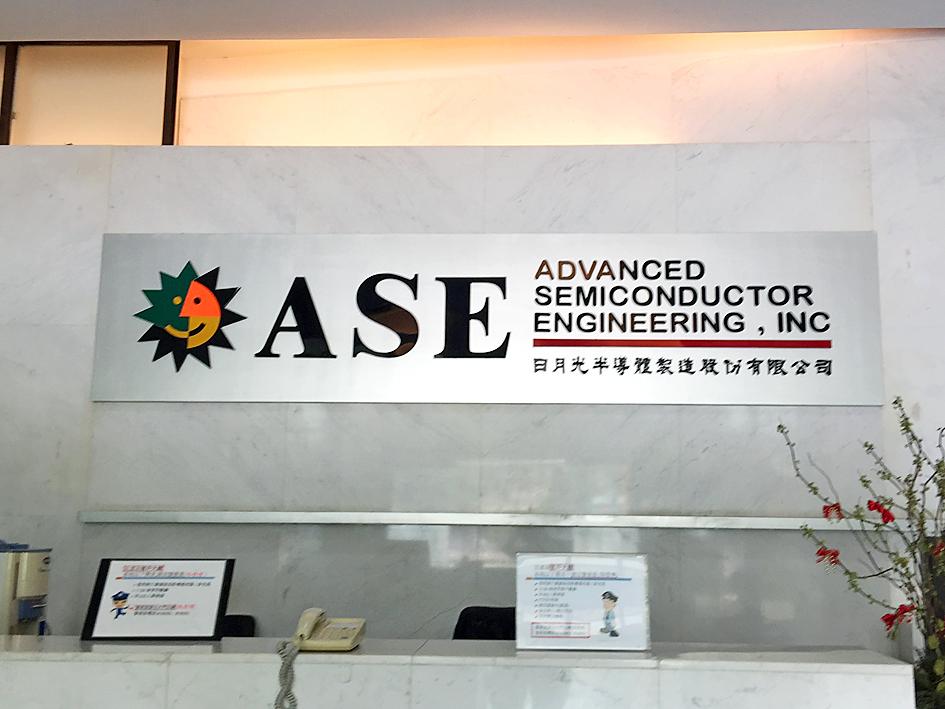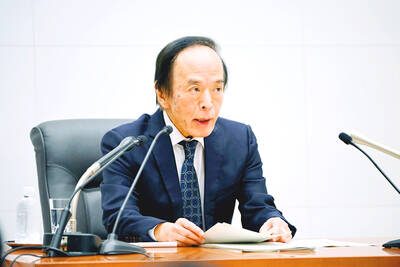ASE Technology Holding Co (ASE, 日月光投控) yesterday said it expects its chip assembly and testing (ATM) service revenue this year to grow two times faster the global semiconductor industry’s as 5G-related applications drive chip demand.
The Kaohsiung-based company said that its ATM revenue last year expanded 10 percent to NT$270.1 billion (US$9.52 billion) from a year earlier.
Global semiconductor industry sales, excluding the memory chip segment, are predicted to grow by 5 to 10 percent this year, ASE said.

Photo: Grace Hung, Taipei Times
The company said it expects ATM capacity constraints to last throughout this year, instead of just the first half, as it had forecast three months ago.
It plans to add 1,800 wire-bonding machines this year to meet customers’ rising demand, ASE said.
“In 2021, [equipment] loading is very strong. We are quite confident about that. Our optimism has extended into 2022,” chief operating officer Tien Wu (吳田玉) told investors at a virtual conference.
To secure as much capacity as they can, about 90 percent of ASE’s wire-bonding packaging service clients have signed two-year supply contracts, Wu said.
Capital expenditure this year would be the same as last year at US$1.7 billion, he said.
ASE’s net profit surged 57 percent to NT$10.04 billion last quarter from NT$6.38 billion a year earlier and grew 50 percent from NT$6.71 billion in the previous quarter.
Net profit last year rose 64 percent to a record-high NT$27.59 billion, from NT$16.85 billion in 2019. That translated into earnings per share of NT$6.47, up from NT$3.96 in 2019.
The company said it expects its ATM business to remain strong this quarter, which is usually a slow season.
However, its electronics manufacturing service business is forecast to weaken, with revenue sliding to about the NT$53.13 billion it registered in the third quarter of last year, it said.
Gross margin should be similar to the 22.6 percent it posted in the previous quarter, it said.

Taiwan Semiconductor Manufacturing Co (TSMC, 台積電) last week recorded an increase in the number of shareholders to the highest in almost eight months, despite its share price falling 3.38 percent from the previous week, Taiwan Stock Exchange data released on Saturday showed. As of Friday, TSMC had 1.88 million shareholders, the most since the week of April 25 and an increase of 31,870 from the previous week, the data showed. The number of shareholders jumped despite a drop of NT$50 (US$1.59), or 3.38 percent, in TSMC’s share price from a week earlier to NT$1,430, as investors took profits from their earlier gains

In a high-security Shenzhen laboratory, Chinese scientists have built what Washington has spent years trying to prevent: a prototype of a machine capable of producing the cutting-edge semiconductor chips that power artificial intelligence (AI), smartphones and weapons central to Western military dominance, Reuters has learned. Completed early this year and undergoing testing, the prototype fills nearly an entire factory floor. It was built by a team of former engineers from Dutch semiconductor giant ASML who reverse-engineered the company’s extreme ultraviolet lithography (EUV) machines, according to two people with knowledge of the project. EUV machines sit at the heart of a technological Cold

TAIWAN VALUE CHAIN: Foxtron is to fully own Luxgen following the transaction and it plans to launch a new electric model, the Foxtron Bria, in Taiwan next year Yulon Motor Co (裕隆汽車) yesterday said that its board of directors approved the disposal of its electric vehicle (EV) unit, Luxgen Motor Co (納智捷汽車), to Foxtron Vehicle Technologies Co (鴻華先進) for NT$787.6 million (US$24.98 million). Foxtron, a half-half joint venture between Yulon affiliate Hua-Chuang Automobile Information Technical Center Co (華創車電) and Hon Hai Precision Industry Co (鴻海精密), expects to wrap up the deal in the first quarter of next year. Foxtron would fully own Luxgen following the transaction, including five car distributing companies, outlets and all employees. The deal is subject to the approval of the Fair Trade Commission, Foxtron said. “Foxtron will be

INFLATION CONSIDERATION: The BOJ governor said that it would ‘keep making appropriate decisions’ and would adjust depending on the economy and prices The Bank of Japan (BOJ) yesterday raised its benchmark interest rate to the highest in 30 years and said more increases are in the pipeline if conditions allow, in a sign of growing conviction that it can attain the stable inflation target it has pursued for more than a decade. Bank of Japan Governor Kazuo Ueda’s policy board increased the rate by 0.2 percentage points to 0.75 percent, in a unanimous decision, the bank said in a statement. The central bank cited the rising likelihood of its economic outlook being realized. The rate change was expected by all 50 economists surveyed by Bloomberg. The